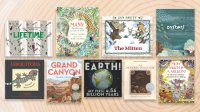Using Picture Books to Teach Children About Large Numbers
These strategies help elementary students grapple with the very large numbers involved in talking about time and space.
Your content has been saved!
Go to My Saved Content.“I have a million things to do.” “You’re one in a million.” “If I had a dollar for every time that happened, I’d be a millionaire.”
In everyday conversation, “a million” usually just means “a lot.” But how much is a million, really? Picturing 1 million of anything is challenging for young children (and adults!). A million years is a long time, yet a single month can seem like an eternity for an 8-year-old waiting for her next birthday.
So how can we help elementary students understand the amount of time required for changes on Earth that have taken millions or even billions of years? Research suggests that . When science, math, and literacy are integrated, students can begin to grasp the concept of very large numbers.
Using Books to Teach Large Numbers
Begin with contextual numbers: As educators, we know that it’s effective to begin a lesson with familiar content. Students know their age and love celebrating their birthday, so start with a book about age, such as , by Sharon Bell Mathis. This classic book features 100-year-old Aunt Dew, who has a special box containing a penny—and a story—for each year of her life.
After listening to or reading the book, students can do the same thing: write and share a memory for each year of their lives, or at least their lives in school. If that seems like a lot to tackle, use : Have each student identify one scientific discovery or invention from the year they were born. Fiber optics and the handheld calculator were invented in our respective birth years.
Build number sense through number facts and models: Next, look for books that engage students with bet-you-didn’t-know large-number facts. , by Lola Shaefer, has wow-factor numbers about animals, such as the fact that the giant swallowtail butterfly will visit 900 flowers in its lifetime. , by Nicola Davies, adds another layer to contextualizing numbers, moving from noting that there are two kinds of elephants to explaining how scientists have found and named over 100,000 kinds of mushrooms. Helping students experience numbers can help them move beyond the theoretical.
Measuring how long a stegosaurus would be if it were in the school hallway can provide a visual of its 30-foot length that sticks with students. Replicating the animals in , by Jan Brett, is another way to build number sense. In small groups, students as young as second grade can research the average size of each animal, create their accurately sized 2D animal on paper, and then work with the other groups to see just how big a mitten would have to be in order to fit all of the animals inside.
Make a million: Scientists often use estimation for large quantities unless precision is required. Bruce Goldstone’s is filled with estimation strategies alongside photographs full of items with which to practice that skill—and no specific answers.
To build estimation skills and actually see one million of something, we love : Give each student a with 10,000 dots, and have them first estimate how many dots are on the page. Next, have them count and highlight the number of dots representing their age, and then do the same to represent the age of the oldest person they know. They can revise their estimation if it has changed before you tell them how many dots there actually are.
The sheet of dots makes a great visual of 10,000 years, which is approximately how long ago woolly mammoths became extinct. If we show 100 dotted sheets, we now have a visual representation of 1 million dots. How many would it take to show the number of years since dinosaurs became extinct? For 65 million years, it would take 6,500 sheets! The David M. Schwartz classic has whimsical illustrations by Steven Kellogg that can continue to build students’ understanding of this huge number.
Connect to the standards: Finally, we’re ready to begin instruction that connects large numbers to the NGSS standards about processes that shape the Earth and space, such as these and standards. In addition to beautiful poems, Joyce Sidman’s begins with a depiction of Earth’s life span of nearly 4.6 billion years using a scale of 1 cm=1 million years and noting the points when different living species appeared.
, by Stacy McAnulty, is a great read-aloud to build on this concept of time. Though you won’t find it on any lists of “best” science books—because Earth can’t really talk—it provides humorous insight into Earth’s development over time (think big bang, Pangea, and the development of life).
To move students out of the fictional depiction of Earth and its development, teachers can use an online for visualization of the physical changes in Earth’s surface over time. Start by exploring changes in your own location for contextual geological history. We use the tool to show how a small portion of Tennessee was under water 85 million years ago, which explains how a clam species can be our state fossil, even though we’re landlocked. , by Alex Nogués, explains a similar process throughout its beautifully illustrated pages. Similarly, Jason Chin’s takes the reader back in time to experience the progression of geological processes that shaped the region.
Many (perhaps millions!) of instructional resources are available for elementary teachers, which can make the selection process overwhelming. These four steps provide a way to support elementary students with developing their number sense and understanding of the vast history of the earth in a contextual and engaging manner.
